
When the wind and waves start to make a fellow sailor's face pale, it's often not far until the first "fish feed". Even experienced sailors, who normally have no problems with seasickness, usually remember a trip on which they felt at least slightly nauseous. This is nothing to be ashamed of, as seasickness is a natural reaction of the body to contradictory sensory impressions, such as the firm cabin ceiling and the rocking movements in heavy seas. Nausea at sea is therefore a motion sickness (kinetosis), and in response to these unfamiliar sensations, the vestibular organ in the inner ear releases various stress hormones.
More about seasickness:
The exact causes of seasickness or travel sickness have not yet been conclusively researched. The current theory is that the illness is triggered by conflicting sensory perceptions. For example, when the inner ear and the mechanoreceptors in muscles and joints register movement, but the eyes do not see movement, such as below deck on a ship. Or on deck, when the eyes stare at a point that does not appear to move, such as the floor of the cockpit.
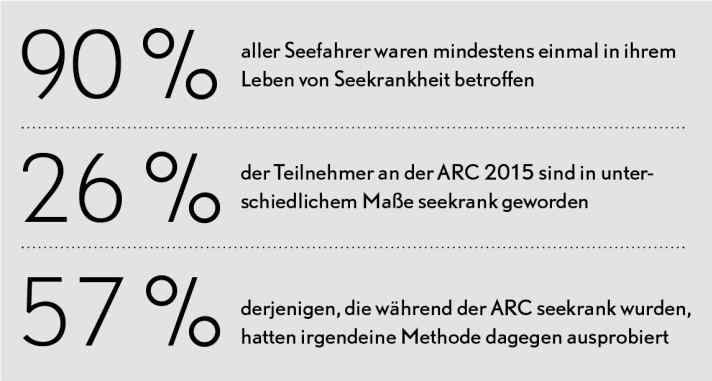
The symptoms of seasickness vary greatly, from mild nausea to extreme despair and the desire to commit suicide, although this is rare. In the Atlantic Rally for Cruisers (ARC), only about 16 per cent of those affected were unable to perform their duties and were constantly vomiting, while the rest remained fit for duty despite occasional vomiting (see graph). In most cases, however, seasickness is temporary and the body adapts to the conditions. Only 3 per cent of those affected on the ARC did not recover, 14 per cent took three days or longer, but for the remainder the nausea subsided after two days or even within a few hours.
Tips against seasickness
1. avoid these foods
The messenger substance histamine is considered to be one of the triggers of seasickness, so avoid food containing histamine before and during the journey, such as Canned or ready meals, alcohol, red wine, cocoa, chocolate, black and green tea, seafood, nuts, tomatoes, strawberries, pulses, citrus fruits, cheese, soya, yeast and wheat products.
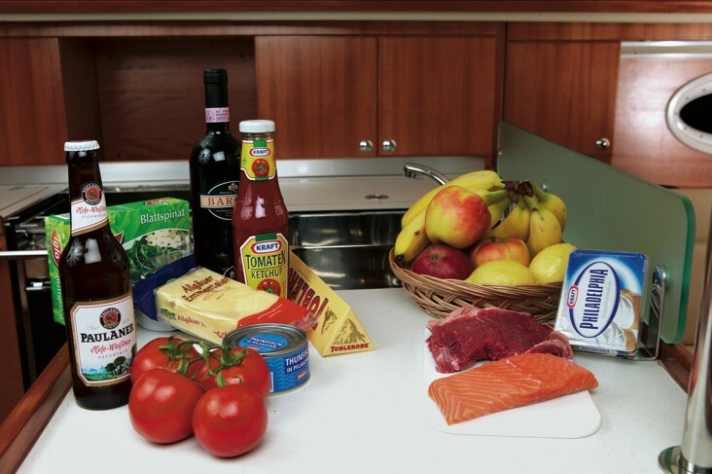
Although fresh meat or white fish are part of a low-histamine diet, they irritate the stomach and lead to increased production of stomach acid. They should therefore not be eaten immediately before the cruise or in large quantities. Bananas, fresh fruit and vegetables (not citrus fruits), raw carrots, soups, rusks, camomile, peppermint and ginger tea are recommended, especially during the cruise. If your stomach does become acidic, you can counteract this with Magaldrat, Rennie, Alka Seltzer and similar antacid agents.
2. go on a well-rested cruise
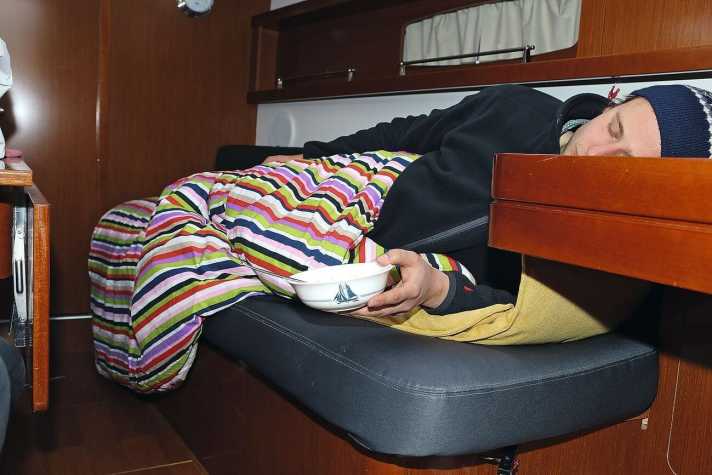
If your body is already exhausted, it won't be long before you feel unwell. Therefore: start the trip well rested and don't look too deeply into your glass the evening before. What's more, hardly anything lowers histamine levels as quickly and effectively as sleeping. A nap can also work wonders during the cruise. Always lie with your feet facing the direction of travel. Avoid freezing, cuddling up and wedging yourself in can help. Lie as close as possible to the centre of gravity of the yacht, as this is where the boat moves the least. However, staying below deck can also have the opposite effect due to a lack of fresh air and a feeling of confinement.
3. home remedy for seasickness
Before reaching for the on-board pharmacy, those affected should try home remedies. The side effects are also limited here.
Ginger Has a stomach-soothing effect, relieves nausea, dizziness and cold sweats. It was already used in ancient seafaring, cut into pieces and chewed, to treat seasickness. It is said to have a similar effect to antihistamines, but not everyone likes the taste. Can also be consumed as ginger tea or candied ginger. Also available as ginger powder (e.g. Zintona capsules).

Vitamin C Breaks down the messenger substance histamine. Professor Dr Reinhart Jarisch has investigated its effectiveness in several studies and has been able to prove it, at least in part. You should start taking one to two grams per day in the week before the trip. Citrus fruits (which can also irritate the stomach), peppers or redcurrants are suitable. It can also be swallowed as a capsule or lozenge (many preparations are available). These are gentle on the stomach during the trip.
Placebo As in many other areas of medicine, the psychological effect also works here, as has been proven. It doesn't matter what is taken: Normal chewing gum or homeopathic globules, eucalyptus sweets or holding a raw potato, parsley in the ear or garlic earrings - it almost doesn't matter what it is, the person concerned just needs to be made to believe that it is effective.
4. distract yourself!
Assign tasks If you are constantly thinking about your nausea, you are unlikely to get rid of it. Therefore, assign tasks to the crew members. The easiest way is to let them take turns steering. As this requires a lot of concentration, it distracts from the nausea. At the same time, the person at the helm gets the feeling that they literally have everything under control. This boosts confidence, which is also an important factor in seasickness; the opposite would be anxiety. Other tasks could be ticking off fairway buoys on the nautical chart, playing games, writing songs, counting rhymes and so on. The main thing is that the person affected is not alone with their - usually destructive - thoughts.
Watch the horizon Looking at the chine has a calming effect and counteracts seasickness; it is best to look forwards. The straight horizon line is a good reference for the eye to detect the movement of the yacht, allowing visual and perceived movement to be harmonised.
In this way, the perceived impression of the ship's movement coincides with visual reality. Glasses that simulate an artificial horizon using liquid in the lens can also help. Acupressure wristbands, which are supposed to reduce seasickness by applying pressure to certain regions of the wrist, are enjoying some popularity. The actual effect of the wristbands is the subject of controversy, but they are certainly not a reliable protection against nausea at sea.
5. reassurance
Enclosures An ideal manoeuvre, also known as tacking, to calm the yacht for a short time. As a rule, the genoa is left back after a tack, the mainsail kills or, usually reefed in a little, is brought in just close enough so that it does not kill. The yacht lies very calmly and reasonably upright at an angle to the waves (detailed report in YACHT 17/2013). The relative calm can be used to make it easier for a seasick person to vomit or to take care of them - to offer encouragement, comfort, make a cup of tea, bring them to their bunk, help them fall asleep.
Motor sailing Using the engine can significantly reduce a yacht's movements, especially on upwind courses. It can be sailed more slowly, but more closely to the wind. The hull works less in the sea due to the lower speed, and the reduced heeling can alleviate feelings of anxiety. Nevertheless, the speed to windward remains the same.
6. medication
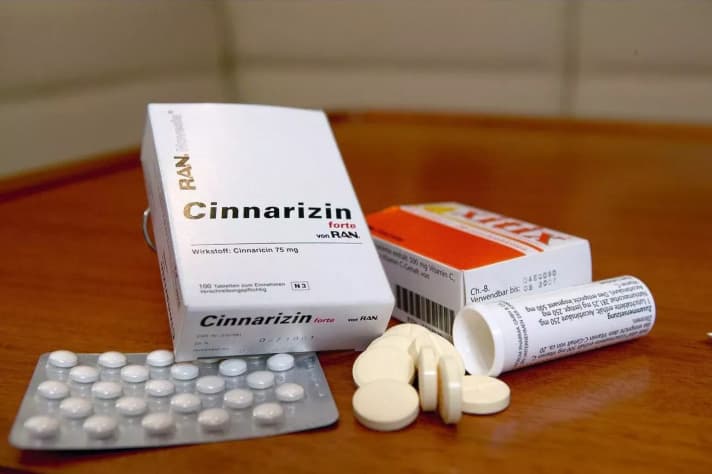
Medication promises a quick end to nausea, but can cause severe side effects. Which medication is suitable depends on various factors, such as the severity of the seasickness, the person's age or their sensitivity to the active ingredients. The side effects can be considerable, so self-medication is not advisable.
Medication with the active ingredients scopolamine, meclozine, dimenhydrinate or cinnarizine are intended to relieve seasickness even after it has already set in. They are available as chewing gum, tablets or plasters. Not all of them are freely available; some require a pharmacy or even a prescription. Pay attention to the side effects. The drugs often cause numbness and drowsiness due to their dampening effect. In particular, the ability to drive is then often no longer guaranteed. It is best to consult your family doctor before use.
A brief overview of the various products and their active ingredients.
Antihistamines Block the histamine receptor. Very well known: Dimenhydrinate, available as chewing gum or tablets (Vomex, Travel gold, Superpep). Should be taken one to two hours before discarding. Side effects: Tiredness, numbness in the mouth. Parasympatholytics Calms the stomach and suppresses nausea in the brain. Often recommended: Scopolamine, applied as a plaster behind the ear, works for up to three days and is considered very effective. Side effects can include visual disturbances, dry mouth and lack of motivation. Calcium channel blockers They work in a similar way to antihistamines, but are said to make you less tired. Cinnarizine is a well-known active ingredient.
7. little helpers
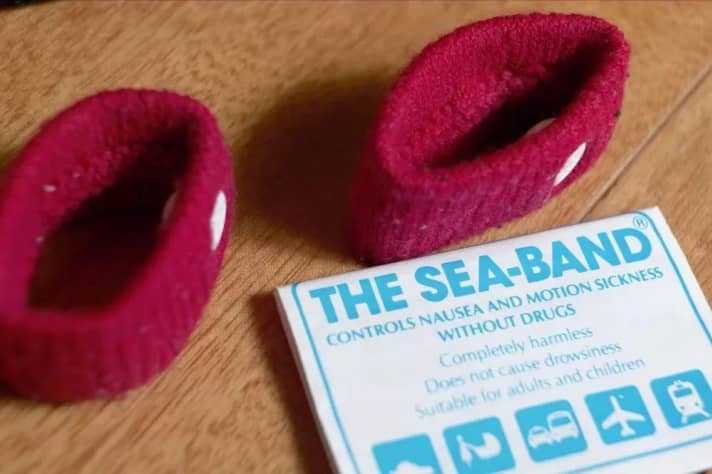
Because the cause of seasickness has still not been fully researched, there are various "little helpers" that promise help in very different ways. A selection.
Acupressure bands Worn around the wrist, a small integrated ball presses on the acupuncture point P6/Nei-Kuan, which is located about two finger widths behind the wrist between the tendons. Stimulating this point is said to have an anti-nausea effect. The bracelet is designed to activate a specific energy point under the skin by applying pressure, which has a positive effect on general well-being. The healing method originally comes from traditional Chinese medicine. However, the method is also said to have a placebo effect.
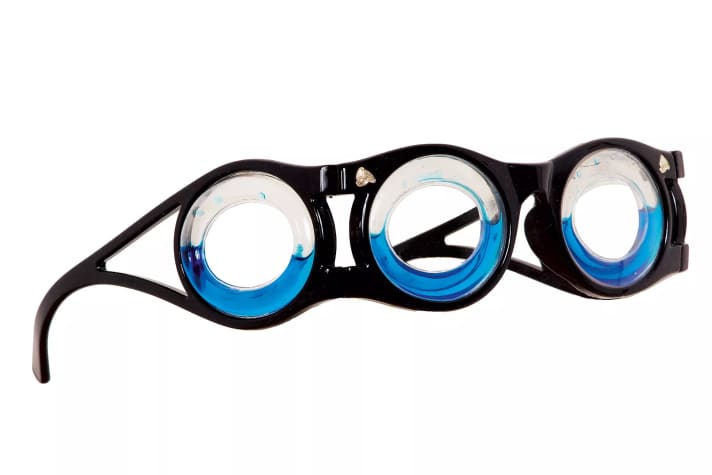
Horizon glasses On deck, looking at the horizon can help against seasickness. Below deck, this is missing and the position information of the vestibular system cannot be visually synchronised. Special goggles that incorporate an artificial horizon - either in the form of narrow bars that can tilt around a pivot point, depending on the angle of the goggles, or by means of coloured liquids that act like a spirit level and also provide the eye with positional information - are intended to help. The glasses are designed to trick the brain into believing that everything is levelled. The movements of the ship are eliminated for the eye by the liquid sloshing in the glasses. Their effectiveness has not been proven either.
Earplugs Insert one of the earplugs for hearing protection into one ear only. This is supposed to influence the vestibular system. This is also said to have helped sailors - or is it just a placebo effect?
8. music - with ACDC against nausea?
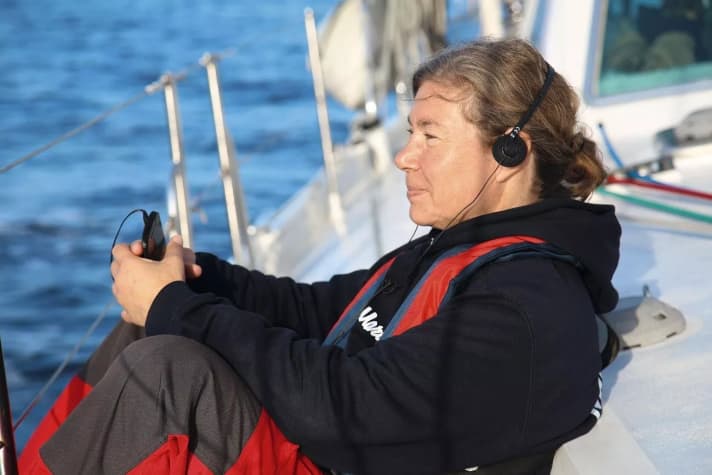
There are numerous myths surrounding seasickness, not least because the causes of the phenomenon are still not fully understood. A particularly creative suggestion: listen to music. Pop or rock songs with around 100 to 120 BPM (beats per minute) roughly correspond to the natural heart rate, which supposedly calms you down. Songs appropriate to the situation might be "I will survive" or "Highway to hell".
9. cruise planning
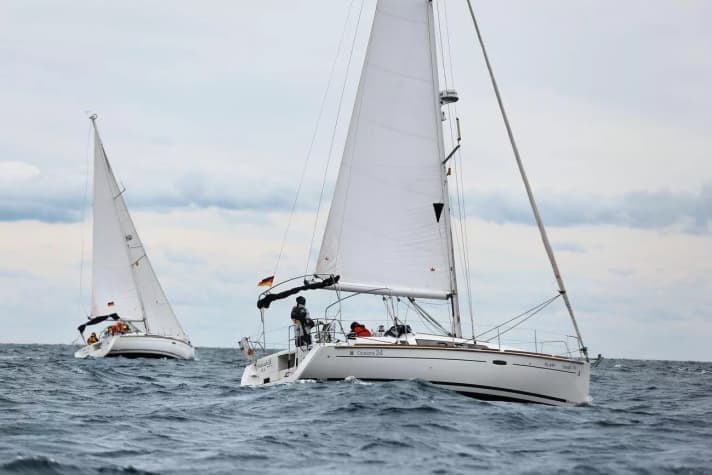
Habituation The body can adjust to the movements of the yacht. However, this takes a few hours or even days. Therefore, during a leg trip, sail short distances first, preferably in moderate conditions. Going sailing often can also help, so don't take too long a stopover.
Reaction If seasickness occurs, it often makes more sense to change the planned route if possible rather than sticking to the course. This can be a diversion around the leeward side of an island, where it is less windy and the sea is calmer, or close to the coast in offshore winds. Smaller course changes often calm the yacht's movements noticeably, but they can mean a longer journey. A deviation from the cruising destination can also make a big difference, i.e. simply calling at a closer harbour and thus shortening the suffering time. It's no use if the planned destinations are beautiful, but nobody wants to sail on afterwards.
10. fresh air and conscious breathing
Avoid foul odours such as vomit, excrement and fuel. Especially when the air below deck is stuffy, they are sure to make you feel sick. Under no circumstances should you stay below deck if you feel nauseous. Due to the lack of a view of the horizon, the brain has no visual cue to process the movements of the ship and consequently sends alarm signals to the body. Peppermint oil under the nose or sweets with essential oils such as menthol or eucalyptus can help. At least in the early stages of seasickness, it usually helps to get some fresh air and look ahead to the horizon. Breathe evenly and consciously, similar to yoga. Keep your head up and turn your body when you turn your head to minimise the discrepancy between the movement you see and the movement you feel. Sit facing the direction of travel. Make sure you wear appropriate clothing! Cold means stress for the body. If you freeze, you put unnecessary strain on your body and reverse the positive effects of the fresh sea air.

